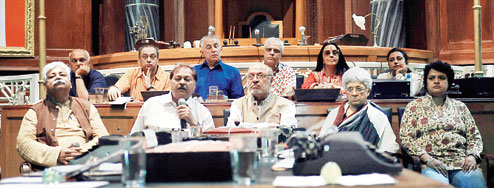-

INTENSE SHOW: The cast on the set of Samvidhaan
Shyam Benegal is seated in front of a console at the verdant Film City studios in Mumbai's Goregaon. A crucial meeting is in session. Congress members in white khadi kurtas and dhotis are seated on the floor, bolsters on the side. Jawaharlal Nehru is there, as are Sardar Vallabhbhai Patel and Maulana Abul Kalam Azad, wearing a long black sherwani and a fez cap.
A black and white map of undivided India marks the period, as do the ceiling fans with their huge inverted bowl-like blades and old-fashioned glass window handles. The table in the corner, where a stenographer is typing out the minutes of a Congress meeting in session, is Victorian, with cabriole legs.
The director asks somebody to check if a Bisleri bottle has been left on the table by mistake. 'No sir, there is just a glass of water,' comes the reply.
The shooting for the series Samvidhaan — Making of the Indian Constitution 1946 to 1949 is being wrapped up. The camera is focused on Govind Ballabh Pant, whose neck, an idle spectator would presume, is shaking with emotion as he gives his assent to the Partition of India.
A little while later, Atul Tiwari, who essays the role of Pant in the show, slumps into a chair, and explains that it is not the Partition that makes him tremble but an actual physical disability. Pant was severely hit by the British police during a lathicharge. 'His neck was almost broken,' Tiwari, who has co-written the Hindi serial with Shama Zaidi, says.
The 10-part mini-series, to be aired on Rajya Sabha TV from January 2014, brings Benegal back to his métier — modern Indian history. The maker of films on Subhash Bose and M.K. Gandhi believes the time has come to take a 'clear and dispassionate look' at what the Indian Constitution means. 'It's an incredible piece of work. It's an organic mutating document,' he said at a recent press conference.
-

Ila Arun as Hansa Mehta
Dalip Tahil plays Nehru in the film and Tom Alter dons the role of Maulana Azad. Sachin Khedekar is B.R. Ambedkar and Utkarsh Mazumdar, Sardar Vallabhbhai Patel.
The scene deals with the Congress working committee meeting that took place soon after June 3, 1947, when Lord Mountbatten announced that India would be partitioned and power would be transferred to two separate states.
Now the camera is on Purshottam Das Tandon, the freedom fighter from Uttar Pradesh who was also Congress president and a strong Hindi advocate. The actor speaking his lines needs a teleprompter.
'As part of the Bharatiya Rashtriya Congress, I have always dreamt of a unified India,' he says in Hindi. 'I do not agree with Mountbatten's resolution on the Partition of India. I would rather accept the slavery of the British than have a partitioned India,' he orates. Patel needs no teleprompter. 'Have we thought what will happen after the British leave India? It is better to cut off a gangrenous portion of your body than live with it.'
-

Shyam Benegal and Sachin Khedekar, who plays B.R. Ambedkar
They are about to shoot the next scene when Benegal hollers to a technician, 'Gangadhar, move out of the frame immediately. Tumhara haath latak raha tha peeche (your hand was dangling in the frame).' He does the needful, and the shooting resumes.
Benegal, who has directed several award-winning films such as Manthan, Nishant and Mandi, believes the series is more 'intense' than Bharat Ek Khoj, which he directed for television 25 years ago. 'You have to pay attention to understand this,' he says.
The story of Samvidhan is set between December 1947 and 1949. But it begins some months before India became independent and carries on until the eve of becoming a republic. 'During this period many things happened. India split into India and Pakistan, so some of the worst things took place then. Despite all of that, we created a very fine, secular Constitution,' Benegal stresses.
Co-writer Zaidi says it took her six months to write the script. The material came from debates, committee meetings and biographies of Nehru and Gandhi. Many of the famous speeches of India's freedom fighters figure in the series.
'Our Constitution has been influenced by the Irish, American, Australian, British and French constitutions. The first draft of the Constitution was written by Sir Benegal N. Rau (an Indian civil servant and jurist) and he was the one who travelled to Ireland and America and met many American senators,' she says. 'Ambedkar was the chairman of the drafting committee.'
Indians had already started drafting a Constitution after the 1857 mutiny or the first war of Independence, she adds. Efforts were also made by Bal Gangadhar Tilak, Annie Besant, Gopal Krishna Gokhale and Motilal Nehru.
-

Divya Dutta as Purnima Banerjee
For the series, a replica of the Central Hall of Parliament during the time of the Constituent Assembly was set up. Benegal moves around the sets, dressed in a blue shirt, a brown waistcoat and grey trousers. When he is around, work takes precedence over everything else. At 78, the filmmaker (who doesn't look a day older than 60) is clearly a legend. But then, of course, he is a chronicler of history.

